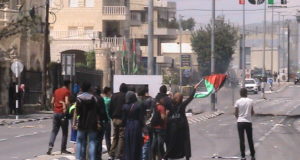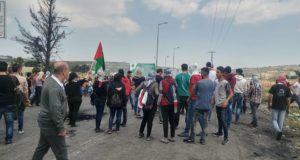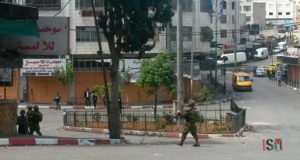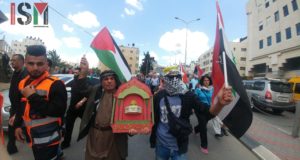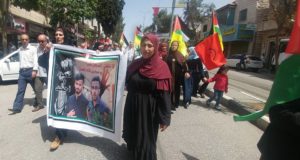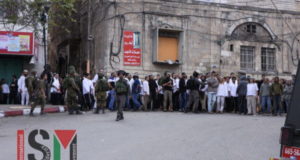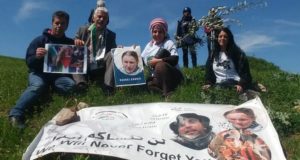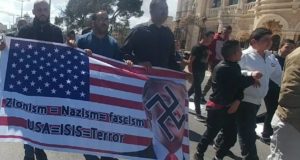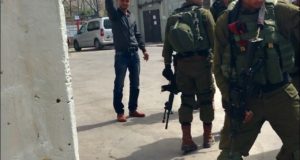On the 14th May 2017, the day the new US embassy to Israel was due to open in Jerusalem, protests were held across Palestine. In Bethlehem, hundreds of children, women and men marched from Nisan Square to the gate in ...
Read More »Many injured in Beit El protest on 15th May in commemoration of the Nakba
Palestinians marched from Arafat square in Ramallah at 11am this morning 15th May to the DCO checkpoint near the illegal settlement of Beit El to confront Israeli forces. At around 12PM there were over 1000 protestors. Israeli forces fired excessive ...
Read More »Israeli soldiers injure 4 unarmed Palestinians in Al-Khalil protest Monday 14th May
On Monday 14th May at 11am, protesters in occupied Al-Khalil gathered at the Hussein Mosque stadium with placards, and marched down to the city centre, gathering there and taking pictures at around 11.30. Around 80 protesters were present, including children ...
Read More »“We witnessed at least 40 Palestinians dropping to the ground from tear gas inhalation”
On Monday the 14th of May at 11am, thousands of Palestinians gathered in Arafat Square in Ramallah and proceeded to march to Qalandiya checkpoint to confront Israeli forces. The US embassy was officially moved to Jerusalem on this same day. ...
Read More »Palestinians hold protest on International Palestinian Prisoners day
17/04/2018 International Solidarity Movement Al Khalil | Hebron Today’s demonstration was held by the Palestinian prisoners club, political factions and Palestinian civil society also in attendance were Palestinian prisoner family members and internationals. Palestinians marched from the stadium in Al ...
Read More »Severe restrictions for Palestinians, freedom of movement for settlers.
02/04/2018, International Solidarity Movement, Al Khalil/Hebron Today Israeli forces sealed off parts of three streets in Palestinian controlled H1 near Bab Azawiyeh ordering more than fifty Palestinian shops to close for ‘security reasons’. Israeli forces also closed the Al Ibrahimi ...
Read More »Palestinian and International activists plant olive saplings on village land ordered for confiscation by Israel in Burin
17/03/2018| International Solidarity Movement Palestinians and International activists successfully planted dozens of olive saplings in the north of West Bank in the village of Burin near Nablus. Palestinians and Internationals together laid pictures of prominent activists in front of the ...
Read More »Palestinians pray in the streets of Bethlehem and march against Donald Trump
16th March 2018 | International Solidarity Movement, al Khalil team | Occupied Palestine This morning, Palestinians gathered in front of the apartheid wall by the Intercontinental Hotel in Bethlehem for Friday Prayer, which was held in the street. After the ...
Read More »Detained and arrested for no reason, Palestinian told it’s his “last chance”
15th March 2018 | International Solidarity Movement, al Khalil team | Occupied Palestine Yesterday, Ayman al Fakhori, age 25, was detained for an hour outside the Ibrahimi Mosque checkpoint before being arrested for no reason and escorted down Shuhada Street ...
Read More »ISM Tours USA : Bring the Palestinian resistance to speak to your community
Are you ready to take your activism for Palestine to the next level? In 2002, the International Solidarity Movement grabbed world attention by bringing volunteers from around the world to defend Palestine through nonviolent resistance. They stayed with resistance fighters in the ...
Read More » International Solidarity Movement Nonviolence. Justice. Freedom.
International Solidarity Movement Nonviolence. Justice. Freedom.
